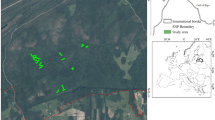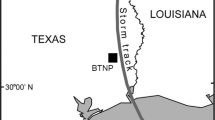Abstract
Context
Since storm damage has a large impact on forest management in Central Europe, we investigated the main storm risk factors for two important conifer species, Douglas-fir (Pseudotsuga menziesii [Mirbel] Franco) and Norway spruce (Picea abies [L.] Karst.).
Aims
We compared general storm damage levels of Douglas-fir and Norway spruce, the latter being known to have high storm risk among European tree species.
Methods
Generalized linear mixed models and boosted regression trees were applied to recorded storm damage of individual trees from long-term experimental plots in southwest Germany. This included two major winter storm events in 1990 and 1999. Over 40 candidate predictors were tested for their explanatory power for storm damage and summarized into predictor categories for further interpretation.
Results
The two most important categories associated with storm damage were timber removals and topographic or site information, explaining between 18 and 54 % of storm damage risk, respectively. Remarkably, general damage levels were not different between Douglas-fir and Norway spruce.
Conclusion
Under current forest management approaches, Douglas-fir may be considered a species with high storm risk in Central Europe, comparable to that of Norway spruce.





Similar content being viewed by others
References
Albrecht A (2009) Sturmschadensanalysen langfristiger waldwachstumskundlicher Versuchsflächendaten in Baden-Württemberg. Dissertation, University of Freiburg
BMVEL (2006) Results from the National Forest Inventory 2001/2. German Federal Ministry of Food, Agriculture and Consumer Protection. Available at http://www.bundeswaldinventur.de/enid/98bb5c5ea761ec258d9e6e619a27f9b2,0/76.html. Accessed 7 September 2012
Bouchon J (1987) État de la recherche relative aux dégâts forestiers dus aux tempêtes. Rev For Fr 39:301–312
Colin F, Vinkler I, Riou-Nivert P, Renaud J-P, Hervé J-C, Bock J, Piton B (2009) Facteurs de risque de chablis dans les peuplements forestiers: les leçons tirées des tempêtes de 1999. In: Birot Y, Landmann G, Bonhême I (eds) La forêt face aux tempêtes. Quae Editions, Versailles, pp 177–228
Cremer KW, Borough CJ, McKinnel FH, Carter PR (1982) Effects of stocking and thinning on wind damage in plantations. N Z J For Sci 12:244–268
Cucchi V, Meredieu C, Stokes A, Coligny FD, Suarez J, Gardiner BA (2005) Modelling the windthrow risk for simulated forest stands of maritime pine (Pinus pinaster Ait.). For Ecol Manag 213:184–196
Dhôte J-F (2005) Implication of forest diversity in resistance to strong winds. In: Scherer-Lorenzen M, Körner C, Schulze E-D (eds) Forest diversity and function. Springer, Berlin, pp 291–307. doi:210.1007/1003-1540-26599-26596_26514
Dobbertin M (2002) Influence of stand structure and site factors on wind damage comparing the storms Vivian and Lothar. For Snow Landsc Res 77:187–205
Elith J, Leathwick JR, Hastie T (2008) A working guide to boosted regression trees. J Anim Ecol 77:802–813
Enke W, Deutschländer T, Schneider F, Küchler W (2005) Results of five regional climate studies applying a weather pattern based downscaling method to ECHAM4 climate simulation. Meteorol Z 14:247–257
Friedman JH, Meulman JJ (2003) Multiple additive regression trees with application in epidemiology. Stat Med 22:1365–1381
Groth O (1927) Die Wurzelbildung der Douglasie und ihr Einfluß auf die Sturm- und Schneefestigkeit dieser Holzart. Offprint Allg For Jagdztg 103 (in German)
Hanewinkel M (2005) Neural networks for assessing the risk of windthrow on the forest division level: a case study in southwest Germany. Eur J For Res 124:243–249
Heidingsfelder A, Knoke T (2004) Douglasie versus Fichte. J.D. Sauerländer’s Verlag, Frankfurt am Main (in German)
Heneka P, Hofherr T, Ruck B, Kottmeier C (2006) Winter storm risk of residential structures—model development and application to the German state of Baden-Württemberg. Nat Hazards Earth Syst Sci 6:721–733
Hermann RK (2005) Wurzelstudien an Douglasie—ein Literaturüberblick. In: Dong PH (ed) Zum Anbau und Wachstum der Douglasie. Mitt Forsch Anst Waldökologie Forstwirtsch Rheinl-Pfalz 55:135–164 (in German)
Johnson M, Kohler G, Omdal D, Kroll A R, Ripley K, Hostetler B, Mathison R, Nelson A (2010) Forest health highlights in Washington 2009. DNR WA, Forest Health Program. Available at http://www.dnr.wa.gov/Publications/rp_fh_2009_forest_health_highlights.pdf. Accessed 7 September 2012
König A (1995) Sturmgefährdung von Beständen im Altersklassenwald. Dissertation, Technical University of Munich (in German)
Lanquaye-Opoku N, Mitchell SJ (2005) Portability of stand-level empirical windthrow risk models. For Ecol Manag 216:134–148
Leckebusch G, Koffi B, Ulbrich U, Pinto JG, Spangehl T, Zacharias S (2006) Analysis of frequency and intensity of European winter storm events from a multi-model perspective, at synoptic and regional scales. Clim Res 31:59–74
Littell RC, Milliken GA, Stroup WW, Wolfinger RD, Schabenberger O (2006) SAS for mixed models, 2nd edn. SAS Institute Inc., Cary
Lohmander P, Helles F (1987) Windthrow probability as a function of stand characteristics and shelter. Scand J For Res 2:227–238
Maccurrach RS (1991) Spacing: an option for reducing storm damage. Scott For 45:285–297
Mason WL, Quine CP (1995) Silvicultural possibilities for increasing structural diversity in British spruce forests: the case of Kielder Forest. For Ecol Manag 79:13–28
Mayer P, Brang P, Dobbertin M, Hallenbarter D, Renaud J-P, Walthert L, Zimmermann S (2005) Forest storm damage is more frequent on acidic soils. Ann For Sci 62:303–311
Mayhead GJ (1973) Some drag coefficients for British forest trees derived from wind tunnel studies. Agric Meteorol 12:123–130
McComb WC, Spies TA, Emmingham WH (1993) Douglas-fir forests—managing for timber and mature-forest habitat. J For 91:31–42
McMinn RG (1963) Characteristics of Douglas-fir root systems. Can J Bot 41:105–122
Nicoll BC, Gardiner BA, Peace AJ (2008) Improvements in anchorage provided by the acclimation of forest trees to wind stress. For 81:389–398
Nicoll BC, Gardiner BA, Rayner B, Peace AJ (2006) Anchorage of coniferous trees in relation to species, soil type, and rooting depth. Can J For Res 36:1871–1883
Quine C (1995) Assessing the risk of wind damage to forests: practice and pitfalls. In: Coutts MP, Grace J (eds) Wind and trees. Cambridge University Press, Cambridge, pp 379–403
Rich RL, Frelich LE, Reich PB (2007) Wind-throw mortality in the southern boreal forest: effects of species, diameter and stand age. J Ecol 95:1261–1273
Ridgeway G (2006) Generalized boosted regression models. Documentation on the R package “gbm”. Available at http://cran.r-project.org/web/packages/gbm/gbm.pdf. Accessed 7 September 2012
Riou-Nivert P (2003) Tempêtes et dégâts aux forêts : évolution sur le XXe siècle. Programme International Géosphère Biosphère–Programme Mondial de recherches sur le climat (PIGB-PMRC) 15:46–49
Rottmann M (1986) Wind- und Sturmschäden im Wald. J.D. Sauerländer’s Verlag, Frankfurt am Main (in German)
Rudnicki M, Mitchell SJ, Novak MD (2004) Wind tunnel measurements of crown streamlining and drag relationships for three conifer species. Can J For Res 34:666–676
Schmid-Haas P, Bachofen H (1991) Die Sturmgefährdung von Einzelbäumen und Beständen. Schweiz Z Forstwes 142:477–504 (in German)
Schmidt M, Hanewinkel M, Kändler G, Kublin E, Kohnle U (2010) An inventory-based approach for modeling single tree storm damage—experiences with the winter storm 1999 in southwestern Germany. Can J For Res 40:1636–1652
Schütz J-P, Götz M, Schmid W, Mandallaz D (2006) Vulnerability of spruce (Picea abies) and beech (Fagus sylvatica) forest stands to storms and consequences for silviculture. Eur J For Res 125:291–302
Spiecker H, Mielikäinen K, Koehl M, Skovsgaard JP (eds) (1996) Growth trends in European forests: studies from 12 countries. Springer, Berlin
Stock M (ed) (2005) Klimawandel—Auswirkungen, Risiken, Anpassung. Potsdam Institute of Climate Impact Research, PIK Report (99) (in German)
Studholme WP (1995) The experience of and management strategy adopted by the Selwyn Plantation Board, New Zealand. In: Coutts MP, Grace J (eds) Wind and trees. Cambridge University Press, Cambridge, pp 468–476
Telewski FW (1995) Wind-induced physiological and developmental responses in trees. In: Coutts MP, Grace J (eds) Wind and trees. Cambridge University Press, Cambridge, pp 237–263
The SAS Institute Inc (2006) The GLIMMIX procedure—June 2006. Available at http://support.sas.com/rnd/app/papers/glimmix.pdf. Accessed 7 September 2012
Von Teuffel K, Heinrich B, Baumgarten M (2004) Present distribution of secondary Norway spruce in Europe. In: Spiecker H, Hansen J, Klimo E, Skovsgaard JP, Sterba H, Von Teuffel K (eds) Norway spruce conversion—options and consequences. Brill, Leiden
Vollsinger S, Mitchell SJ, Byrne KE, Novak MD, Rudnicki M (2005) Wind tunnel measurements of crown streamlining and drag relationships for several hardwood species. Can J For Res 35:1238–1249
Acknowledgments
The authors would like to thank Dr. Edgar Kublin for statistical consulting and Ms. Robin Hillestad for native English language reviewing of this publication.
Funding
This study was partly funded by the German Federal Ministry of Education and Research under funding code 0330622 and by the Forest Research Institute Baden-Württemberg. The authors are responsible for the contents of this publication.
Author information
Authors and Affiliations
Corresponding author
Additional information
Handling Editor: Barry Alan Gardiner
Rights and permissions
About this article
Cite this article
Albrecht, A., Kohnle, U., Hanewinkel, M. et al. Storm damage of Douglas-fir unexpectedly high compared to Norway spruce. Annals of Forest Science 70, 195–207 (2013). https://doi.org/10.1007/s13595-012-0244-x
Received:
Accepted:
Published:
Issue Date:
DOI: https://doi.org/10.1007/s13595-012-0244-x




